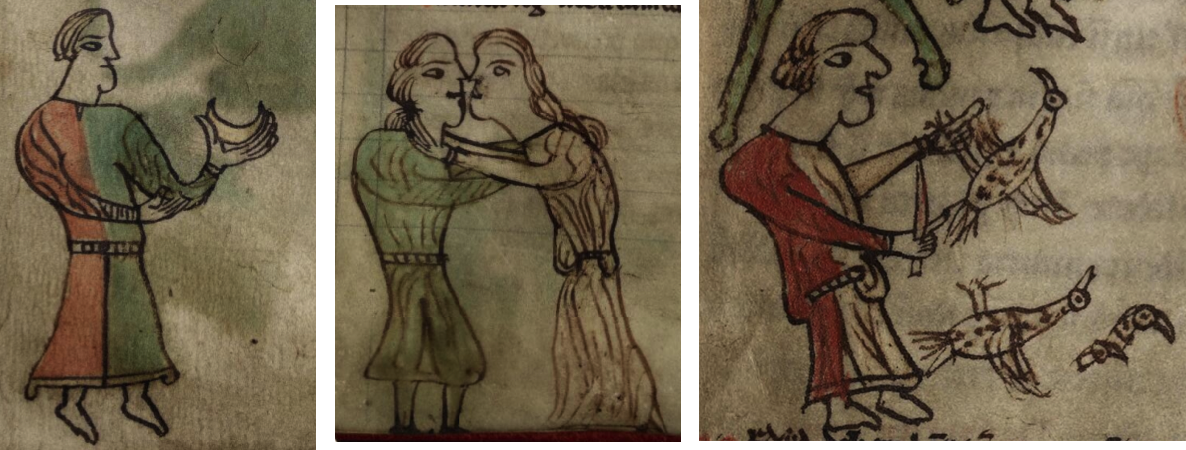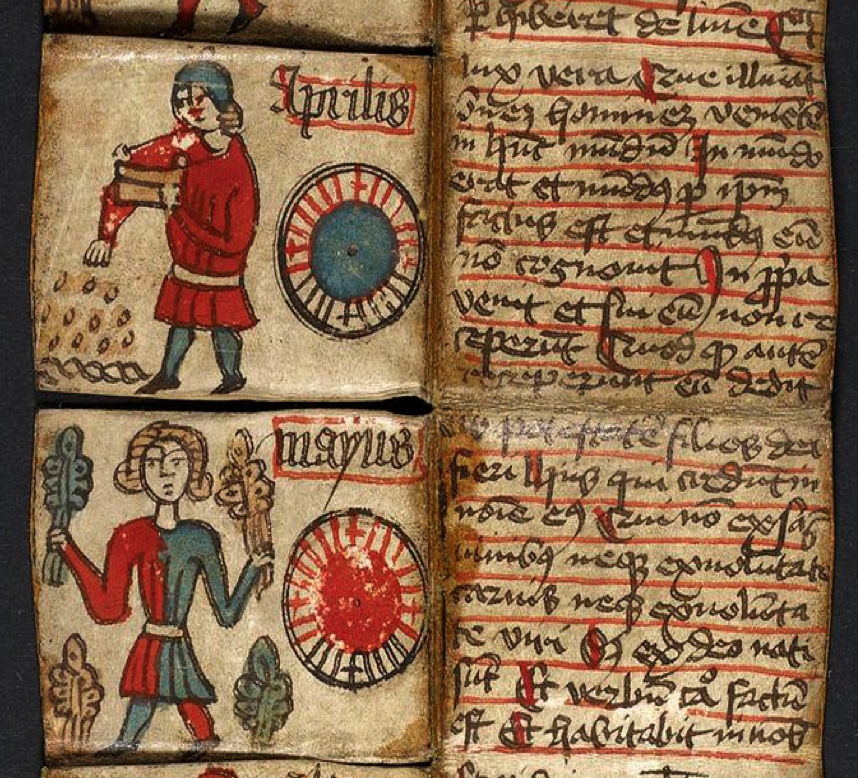The Ghâyat al-Hakîm fi’l-sihr (the “Picatrix”) is an occult manuscript brought to my attention on the Voynich.ninja forum and in a comment by K. Gheuens. I had noted some similarities between the VMS dragon-critter and some of the VMS men, with illustrations I saw in an Icelandic text. The Picatrix includes some provocative drawings of figures proportioned like the VMS archer.
The Picatrix
The Picatrix brings together older writings on proto-science, prayers, magic, and astrology.
It was written in Arabic around the 10th century and was translated into Spanish in the mid-13th century and, afterward, from Spanish into Latin (Benedek Lang, 2010). It is mentioned in two of the volumes by 16th-century polymath Johannes Heidenberg, commonly known as Trithemius, who is famous for his contributions to the history of cryptography. The Arabic Picatrix was apparently not known in the west until about 1920 (W. Hartner, Isis, V. 56, 1965).
The Picatrix (Biblioteka Jagiellonska MS 793) includes many interesting details. The origin of this version is debated, and the text breaks off abruptly in the second of four parts, but it is thought to have been created by a Polish scribe in Italy, or possibly in the region around Kraków. Its creation date is estimated to be in the mid-15th century, with a binding date around 1460 (B. Lang, Unlocked Books, 2010). Lang describes it as the only illustrated copy. Fortunately, the illustrations continue beyond the disrupted text.
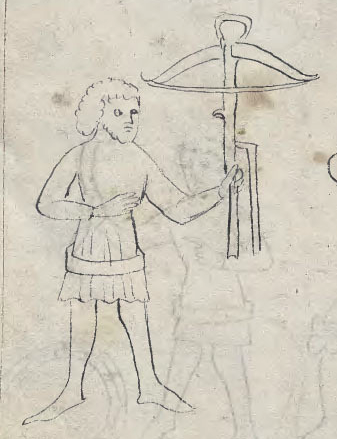 For Voynich researchers, there are a number of interesting details. As examples, in the astrology section, there are two long-triggered crossbows held by figures with legs, as well as a number of figures holding ball-like forms. There are many wearing plain-necked tunics similar to the VMS archer’s, except that the sleeves are not as wide at the elbows.
For Voynich researchers, there are a number of interesting details. As examples, in the astrology section, there are two long-triggered crossbows held by figures with legs, as well as a number of figures holding ball-like forms. There are many wearing plain-necked tunics similar to the VMS archer’s, except that the sleeves are not as wide at the elbows.
Of particular interest is a panel of figures in a style that differs from the rest of the manuscript. K. Gheuens commented on the drawings when discussing proportions of the nymphs in October 2016.
For those who haven’t seen them, here are the figures, which strike me as very King Arthurish. There is a figure with an extravagant cape and a forked beard, in the middle a female, and possibly a knight on the right, oddly holding his sword by the blade. They are distinctly long in the waist and short in the legs, like the VMS archer:
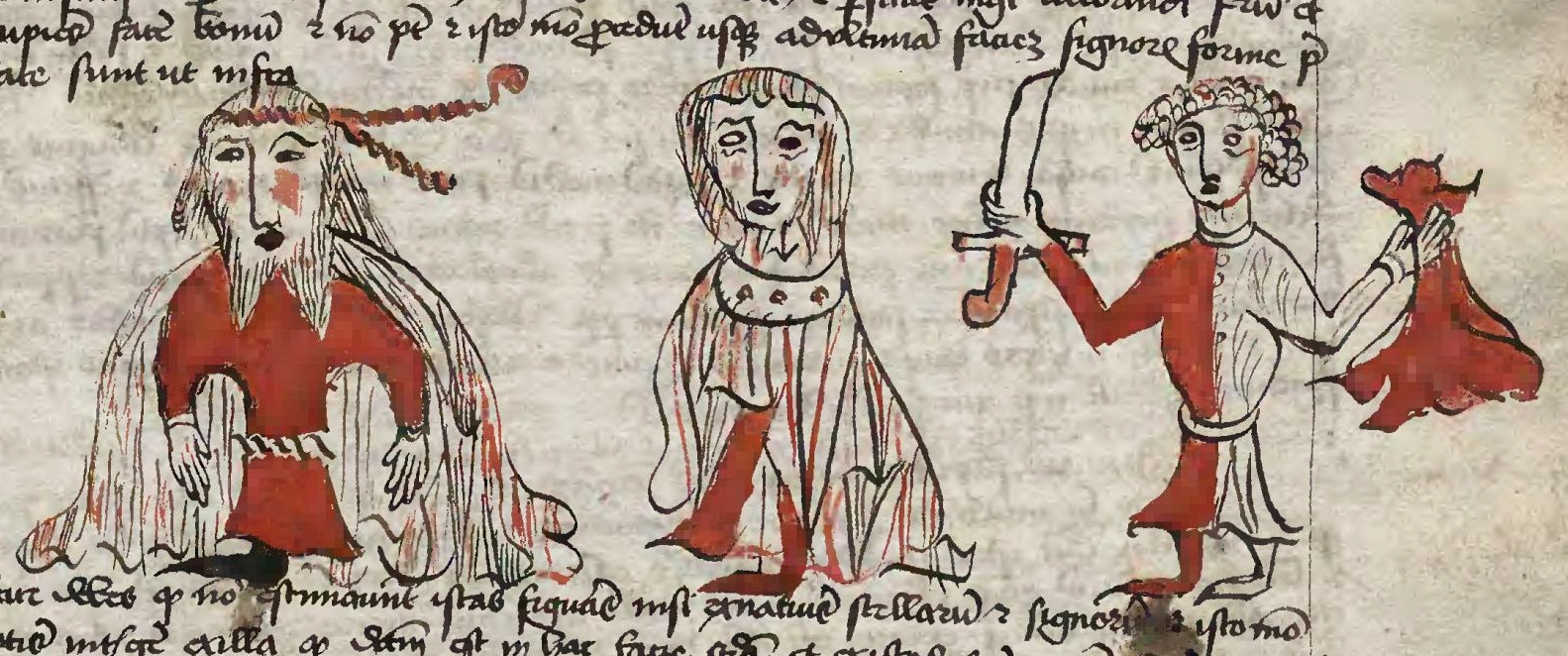 I have a particular interest in these figures because I noticed a similarity between them and those in another manuscript, one that was created in Wales. The history of the Picatrix manuscripts does not include any mention of Wales, and a search of the Web did not yield any comments connecting the Picatrix figures and those in this Welsh manuscript, so this may be the first time the connection has been noted.
I have a particular interest in these figures because I noticed a similarity between them and those in another manuscript, one that was created in Wales. The history of the Picatrix manuscripts does not include any mention of Wales, and a search of the Web did not yield any comments connecting the Picatrix figures and those in this Welsh manuscript, so this may be the first time the connection has been noted.
Leges Hywel Dda
The Leges Hywel Dda is a book of Welsh law. John Dee wrote comments on the version that is now Leges Walliae, Oxford, Merton College MS 323. The copy that includes the illustrations that follow is the Leges Hywel Dda, available from the National Library of Wales.
The figures in the Picatrix and the Leges Hywel Dda are clearly not drawn by the same person and it’s not common for a book on the occult to share similarities with a book of law, but there are details that suggest that one illustrator may have seen the works of the other, or that the illustrators might have some kinship in terms of blood, culture, or education.
First, a note about the differences… the Picatrix drawings are scratchy, with tentative strokes, stubby chins, and bodies all facing front, the Hywel Dda are drawn with a cleaner line, faces turned sideways, distinct necks and chins, but…
note the similarity in dress and proportions of the figure on the right. He is wearing a red and white tunic and is holding his sword or long knife by the blade in the Picatrix and almost by the blade in the Hywel Dda. The figure on the right in the Hywel Dda Picatrix appears to have been explicitly drawn with legs that are shorter than the figures on the left.
Other similarities include the wide, very rounded shoulders, the lack of ears, and the concave flare of the tunic from waist to hem. In both the tunic billows out above the waist, although in one it hangs over the edge of the belt. In both cases, the man with the blade is standing on the following text, with his foot touching the letters:
The National Library of Wales has this to say about its early provenance of the Leges Hywel Dda:
“It is known that, by the beginning of the 14th century, the manuscript was at St Augustine’s Abbey, Canterbury. The evidence for this comes from one of two pastedowns preserved at the end of the volume. These are all that remain of the original ‘old oak boards binding’ seen by J. Gwenogvryn Evans at the end of the 19th century, when it was still at Peniarth, Merionethshire. One of these bears the press-mark of the library of St Augustine’s Abbey, Canterbury, and the name of the donor, now partly illegible but interpretable as that of William Byholte (fl. 1292-1318), prior of the abbey. It is also thought that this was the copy of the Welsh laws consulted by John Peckham, archbishop of Canterbury, 1279-94, when he sent his letter to Prince Llywelyn ap Gruffudd in 1282, denouncing the prince’s morals and those of the Welsh, and in which he makes two references to the Laws of Hywel Dda.”
Thus, we find that this edition of the Leges Hywel Dda predates the illustrated edition of the Picatrix by at least 150 years, which brings up some questions:
- Did the illustrator of the unusual panel of illustrations in the Picatrix see this specific copy of the Leges Hywel Dda? It seems unlikely that a book of Welsh law would go far beyond the boundaries of Wales, but the scholars themselves were quite nomadic, often studying at several universities, and taking patronage and appointments in a variety of courts, some quite distant from their homelands. It’s also noteworthy that the illustrated copy is in Latin, not Welsh, a language known by most scholars of the time. There is also a half century, from c. 1500 to c. 1550 in which the whereabouts of the Leges Hywel Dda is not known, or
- Is there an earlier exemplar that includes a figure with short legs, dressed in a bicolor tunic, clutching a knife or sword in a less-than-optimum way?
Searching for the Short-Legged Knight
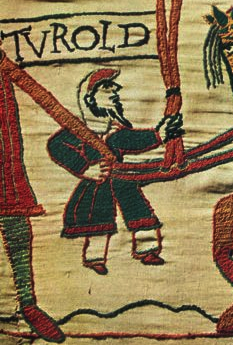 The character of Turold in the Bayeux Tapestry might serve as an exemplar for a short-statured character. He is often called a dwarf, but Turold, while small, is of relatively normal proportions compared to the VMS archer and the Leges Hywel Dda figure. Turold’s clothing isn’t similar either. He wears long wide pants and a cowl and has a distinctively long goatee.
The character of Turold in the Bayeux Tapestry might serve as an exemplar for a short-statured character. He is often called a dwarf, but Turold, while small, is of relatively normal proportions compared to the VMS archer and the Leges Hywel Dda figure. Turold’s clothing isn’t similar either. He wears long wide pants and a cowl and has a distinctively long goatee.
I think we can rule out Turold as the inspiration for the short-legged figures.
The character of Lancelot, from the Arthurian Legends, is often shown in red and white garb, but I’ve never seen him with unusually short legs.
Hunting for an exemplar can be a time-consuming and exasperating task. Sometimes one has to move on and hope that one finds clues along the way, or that someone else comes across a possible precedence.
Summary
I don’t have any explanations for the short-legged character, other than a few rough ideas, but since he sometimes appears in combination with long-legged figures, the proportions appear deliberate in at least some manuscripts. I can’t help wondering if he is based on a legendary character.
I was intrigued by details in drawings that might indicate a connection between a central European book of magic and a Welsh book of law.
One thing I’d like to mention in closing is that the figure clutching the blade of the long knife in the Picatrix struck me as odd in the same way as the VMS crayfish with legs coming out of its tail—an anatomical oddity I’ve never seen in another lobster/crayfish drawing. One can’t directly equate an incautious knight with a leg-challenged crustacean, but it’s a reminder that some people have a slightly different perception of the world and perhaps the VMS illustrator was one of them.
Postscript (5 hours later):
I neglected to include this in my original post. It’s a Danish almanac, written in Latin, from the early 16th century. The lower figure in particular is similar in pose and features to the Picatrix illustrations (in the sense of having round shoulders, a front-on viewpoint, two-toned tunic, and short legs), but more similar to the Welsh manuscript in the sense of having fewer, more assured strokes of the pen. The figure in the all-red tunic it is not quite as clearly short-legged—note how the head is smaller in proportion to the body than the other—but still leans toward having shorter legs. There are several centuries separating these from the Welsh law book, so it’s difficult to know if there is any connection, but the images relate well to the subject of costumes and body proportions:
J.K. Petersen
© Copyright 2017 J.K. Petersen, All Rights Reserved

